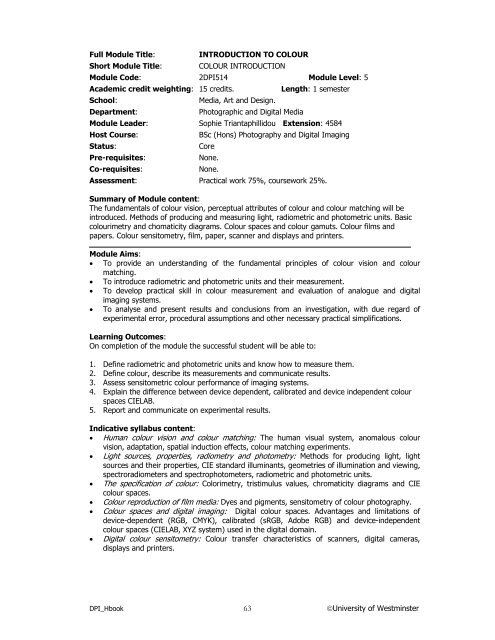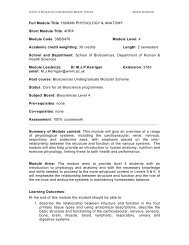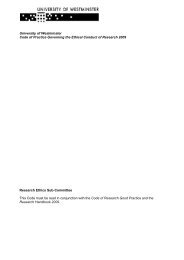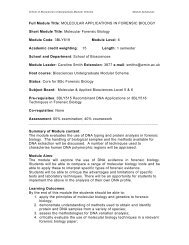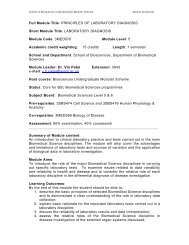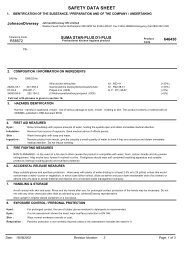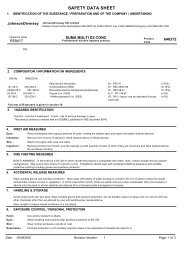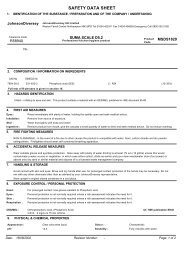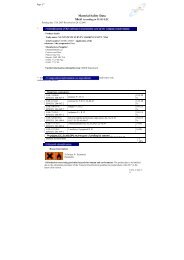CONTENTS 1. Introduction 1.1 Course Outline 1 1.2 Introduction ...
CONTENTS 1. Introduction 1.1 Course Outline 1 1.2 Introduction ...
CONTENTS 1. Introduction 1.1 Course Outline 1 1.2 Introduction ...
Create successful ePaper yourself
Turn your PDF publications into a flip-book with our unique Google optimized e-Paper software.
Full Module Title:<br />
INTRODUCTION TO COLOUR<br />
Short Module Title: COLOUR INTRODUCTION<br />
Module Code: 2DPI514 Module Level: 5<br />
Academic credit weighting: 15 credits.<br />
Length: 1 semester<br />
School:<br />
Media, Art and Design.<br />
Department:<br />
Photographic and Digital Media<br />
Module Leader: Sophie Triantaphillidou Extension: 4584<br />
Host <strong>Course</strong>:<br />
BSc (Hons) Photography and Digital Imaging<br />
Status:<br />
Core<br />
Pre-requisites:<br />
None.<br />
Co-requisites:<br />
None.<br />
Assessment: Practical work 75%, coursework 25%.<br />
Summary of Module content:<br />
The fundamentals of colour vision, perceptual attributes of colour and colour matching will be<br />
introduced. Methods of producing and measuring light, radiometric and photometric units. Basic<br />
colourimetry and chomaticity diagrams. Colour spaces and colour gamuts. Colour films and<br />
papers. Colour sensitometry, film, paper, scanner and displays and printers.<br />
Module Aims:<br />
• To provide an understanding of the fundamental principles of colour vision and colour<br />
matching.<br />
• To introduce radiometric and photometric units and their measurement.<br />
• To develop practical skill in colour measurement and evaluation of analogue and digital<br />
imaging systems.<br />
• To analyse and present results and conclusions from an investigation, with due regard of<br />
experimental error, procedural assumptions and other necessary practical simplifications.<br />
Learning Outcomes:<br />
On completion of the module the successful student will be able to:<br />
<strong>1.</strong> Define radiometric and photometric units and know how to measure them.<br />
2. Define colour, describe its measurements and communicate results.<br />
3. Assess sensitometric colour performance of imaging systems.<br />
4. Explain the difference between device dependent, calibrated and device independent colour<br />
spaces CIELAB.<br />
5. Report and communicate on experimental results.<br />
Indicative syllabus content:<br />
• Human colour vision and colour matching: The human visual system, anomalous colour<br />
vision, adaptation, spatial induction effects, colour matching experiments.<br />
• Light sources, properties, radiometry and photometry: Methods for producing light, light<br />
sources and their properties, CIE standard illuminants, geometries of illumination and viewing,<br />
spectroradiometers and spectrophotometers, radiometric and photometric units.<br />
• The specification of colour: Colorimetry, tristimulus values, chromaticity diagrams and CIE<br />
colour spaces.<br />
• Colour reproduction of film media: Dyes and pigments, sensitometry of colour photography.<br />
• Colour spaces and digital imaging: Digital colour spaces. Advantages and limitations of<br />
device-dependent (RGB, CMYK), calibrated (sRGB, Adobe RGB) and device-independent<br />
colour spaces (CIELAB, XYZ system) used in the digital domain.<br />
• Digital colour sensitometry: Colour transfer characteristics of scanners, digital cameras,<br />
displays and printers.<br />
DPI_Hbook 63 ©University of Westminster


